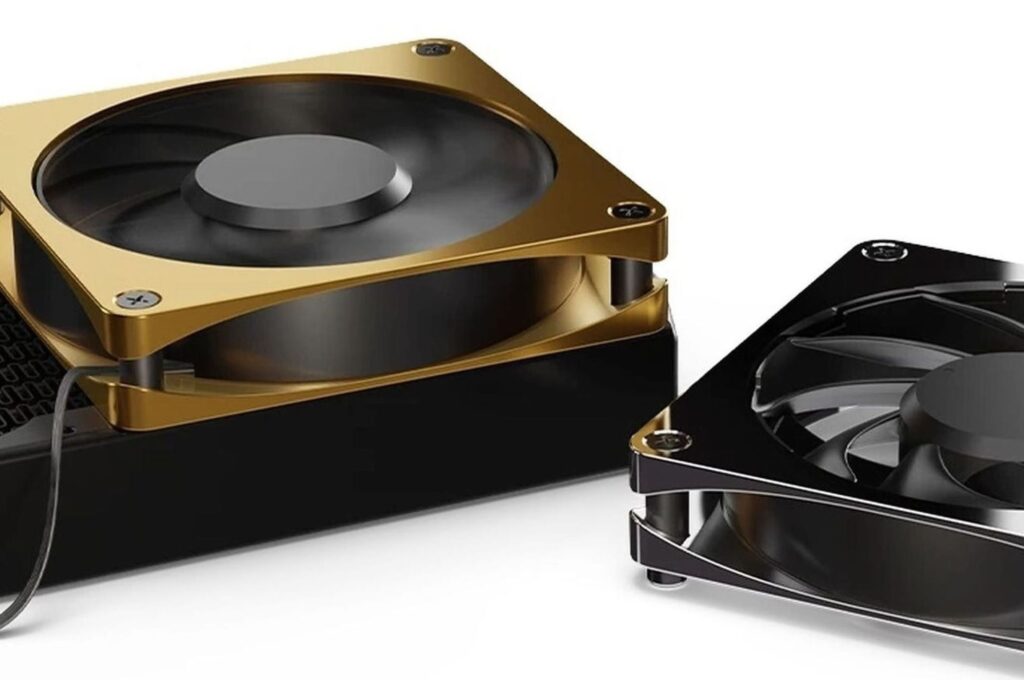Alphacool Apex Stealth
Alphacool has unleashed the new Apex Stealth fans on the world, which attract attention for two things in particular. Firstly, the fact that they contain robust metal elements and secondly, the specifications. These seem to be literally incredible, and while we have no doubt that the efficiency of these fans will be top notch, it’s hard to find elements for which they should be “the best”, as the specs suggest.
Compared to competing fans, the Apex Stealth is clearly differentiated by the use of a metal frame cover. This is die-cast zinc, and you can clearly see from Alphacool’s very nice illustration how it is implemented into the fan. These are basically flanges that are clamped by a circular frame with the motor. The structure of the latter is already made of some kind of plastic, as is the case with the rotor. It’s hard to say exactly what kind of plastic, Alphacool doesn’t specify it, but it’s definitely not anything metallic.
Unlike, for example, the full-metal all-metal Prolimatech Vertex fans, only the frame cover is metal on the Apex Stealth. To suppress vibrations, there is a rubber ring between the frame and the plastic stator frame. If it doesn’t work perfectly and the fan transfers some vibrations to the frame, because of the high hardness of the material, vibrations may be more efficiently transferred to a case skeleton or a radiator than if the design were made of a traditionally softer material. However, we assume that Alphacool has taken good care of this and vibrations do not reach the frame and when they do, they do so only to a negligible degree that will not be a source of secondary noise (by vibrating the body with which the fan is in contact).
As we mentioned in the intro, the top notch specs are supposed to be the main appeal, which if true, would make this perhaps the most efficient 120mm radiator fan ever. At this point, we would like to pause and elaborate on a few technical details that do not support such features. By the following we certainly do not want to question the work of anyone from Alphacool and on the contrary we take our hats off to them for an extremely impressive design, but at the same time, in the context of a fair free competition, we would like to somewhat tone down the enthusiasm that may prevail amongst users when looking at the parameters.
There can be no doubt about the top-notch efficiency of the Apex Stealth fans, as they are built on a very efficient geometry, but there are a few question marks when it comes to the airflow and static pressure parameters. At a speed of 2000 rpm, an airflow of 130.5 m3/h is supposed to be achieved. That’s roughly 36% above the design-wise very similar Cooler Master Mobius OC, which apparently also has a slightly wider rotor and yet a comparably sized hub.
The “effective” area figure (made up of the difference between the total area of the rotor and the area of the hub) will thus rather play against the Apex Stealth. The static pressure at the same speed is supposed to be about twice as high (3.88 mm H2O) for Alphacool fans compared to the CM Mobius OC, which is even more eye-popping. This would not be physically possible with nearly identical designs (9 blades with comparable curvature, blade spacing and rotor to frame spacing) even if the hoop-to-frame spacing was half the size. The profile thickness is the standard 25 mm. If someone from Alphacool can come up with a reasonable technical explanation of what allows such a high static pressure to be achieved compared to geometrically almost identical solutions, we will be happy to publish it.
There are two speed variants of the Alphacool Apex Stealth fan. The faster one (400–3000 rpm) has the additional designation “Power” in the name, the slower one (400–2000 rpm) is without it. Both are then available in four colours (with white, matte black, chrome and gold covers). All fans (slower and faster) have the same suggested price of 30 EUR, at which you can pre-order it at shop.alphacool.com.
English translation and edit by Jozef Dudáš
- Contents
- Alphacool Apex Stealth
